US Federal Reserve officials left interest rates unchanged at their July meeting, as economists had expected, and hinted that recent progress in lowering inflation could enable them to cut interest rates soon.
The Fed decided on Wednesday to hold interest rates steady at about 5.3 percent — a two-decade high where they have remained for a year now. Notably, though, officials also tweaked their post-meeting policy statement to call price increases only “somewhat elevated” and to underscore that officials are attentive not just to the risk of lingering inflation but also to the threat of a job market slowdown.
Central bankers did not release a fresh set of quarterly economic projections at this meeting. Jerome H. Powell, the Fed chair, will deliver a news conference, which is scheduled to start at 2:30pm EST.
The Fed’s decision leaves all eyes on September 18, when policymakers will next vote on interest rates. Investors widely expect them to cut borrowing costs at that gathering, and then to cut rates a second and even third time before the end of the year.
The Fed’s statement on Wednesday is likely to reinforce expectations for a coming rate reduction, because officials used it to stress both that inflation is cooling and that they are increasingly focusing on the health of the labour market.
“The economic outlook is uncertain, and the committee is attentive to the risks to both sides of its dual mandate,” the Fed said in its statement, replacing previous language that said the Fed was “highly attentive to inflation risks.”
The Fed has two main goals: it is supposed to keep inflation low and stable while maintaining a strong job market. When inflation was painfully high in 2022 and 2023, officials were more intently focused on the inflation side of that mandate. But as price increases have come down, they have begun to pay more attention to the employment situation.
Given that, both price increases and jobs data will inform what comes next for interest rates.
Inflation is now cooling meaningfully after proving surprisingly stubborn early in 2024. The latest report showed that the Fed’s preferred price index picked up just 2.5 per cent over the year through June. That is still quicker than the central bank’s 2 per cent target, but much slower than that measure’s recent peak in 2022, which was above 7 per cent.
At the same time, the job market has shown some early signs of weakness. While the unemployment rate is still low by historical standards, it has ticked up recently. Employers have fewer unfilled job openings, and wage growth has been cooling.
As inflation slows and the labour market softens, Fed officials have signaled it is unlikely they will need to keep rates this high for much longer.
Elevated interest rates make it more expensive to take out a mortgage, a car loan or a business loan, slowing consumer demand and company expansions and slowly cooling growth.










